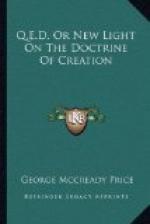“Some years ago we had a parasite of a very destructive aphid down in our books as Lysiphlebus tritici. In carrying out our investigations it became necessary to find out whether this parasite had more than a single host insect, and whether it could develop in more than one species of aphid. To this end, recently emerged males and females were allowed to pair, after which the female oviposited in several species of aphids. Both parents were then killed and preserved and all of their progeny not used in further experiments were also preserved, and thus entire broods or families were kept together. In this way females were reared out of one host species and allowed to oviposit in others, until, often after several hosts had been employed, it would be bred back into the species whence it first originated. In all cases the host was reared from the moment of birth, while with the parasite both parents and offspring were kept together.
“The result of this little fragment of work was to send two genera and fourteen species to the cemetery—you may call it Mt. Synonym Cemetery, if you choose—while the insect involved is now Aphidius testaceipes. The systematist who studies only dried corpses will soon be out of date."[22]
[Footnote 22: F.M. Webster, of the U.S. Dept. of Agriculture, in Science, April 12, 1912, p. 565.]
IV
Now all this is not given to intimate that there is no scientific justification for the term “species,” but to make plain to my non-professional readers what every well-informed biologist already knows, namely, that at the present time the “species question” is still in a very unsatisfactory state. The facts given above would strongly suggest that there probably is indeed such a thing as a species, in the sense assigned by Linnaeus, who as we have seen wished to make it a designation covering all the descendants of each distinct kind originally created. But this original aim of Linnaeus is to-day not merely ignored but treated with lofty contempt; for according to the prevailing theories of evolution, all the manifold diversities of life in our modern world have come about gradually as the result of a slow development by natural process, and hence it would be vain beyond measure to attempt to determine the limits of a “species” in the sense understood by Linnaeus.
But we may conclude, from the facts presented above, that if there is such a naturally delimited group as a “species” in the Linnaean sense of the word, it by no means coincides with what now passes under this name, but might include many so-called species, often a whole genus, or even several.
With this in mind, we must pass on to consider the next step in our study, as to whether new “species” are now coming into being in our modern world under scientific observation, either natural or artificial.




